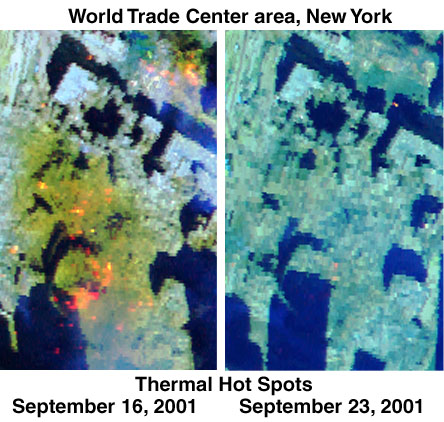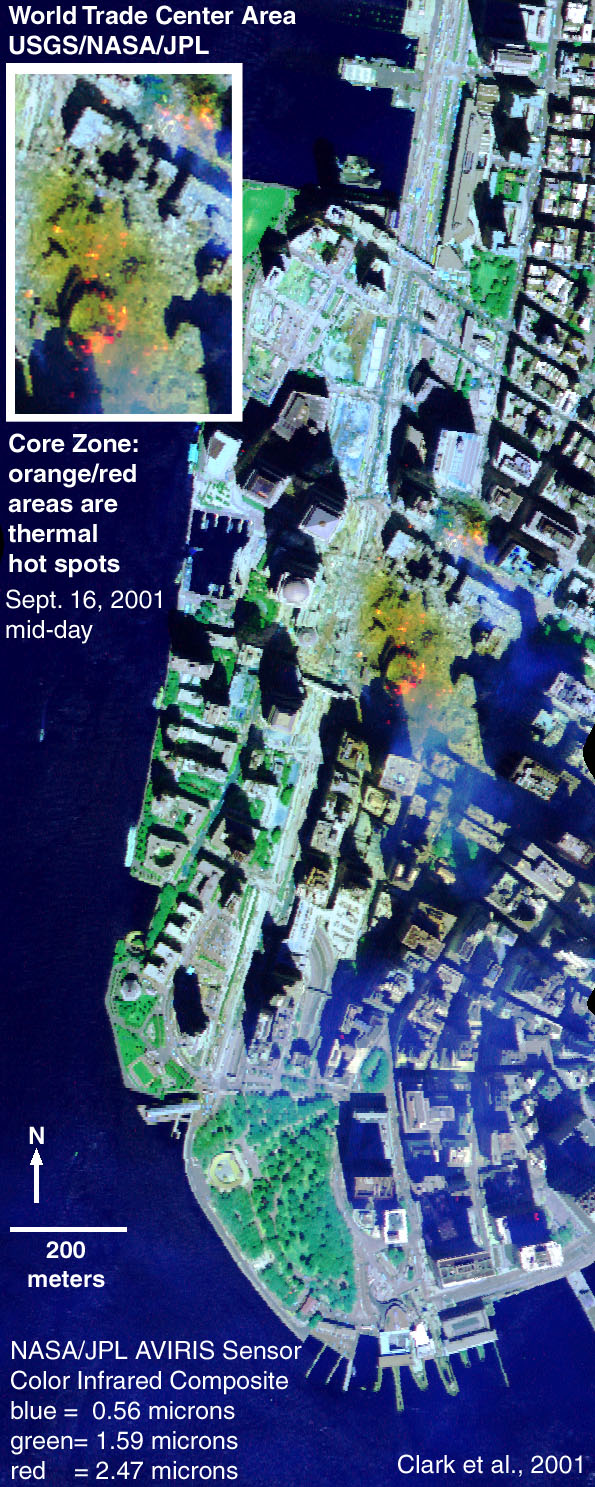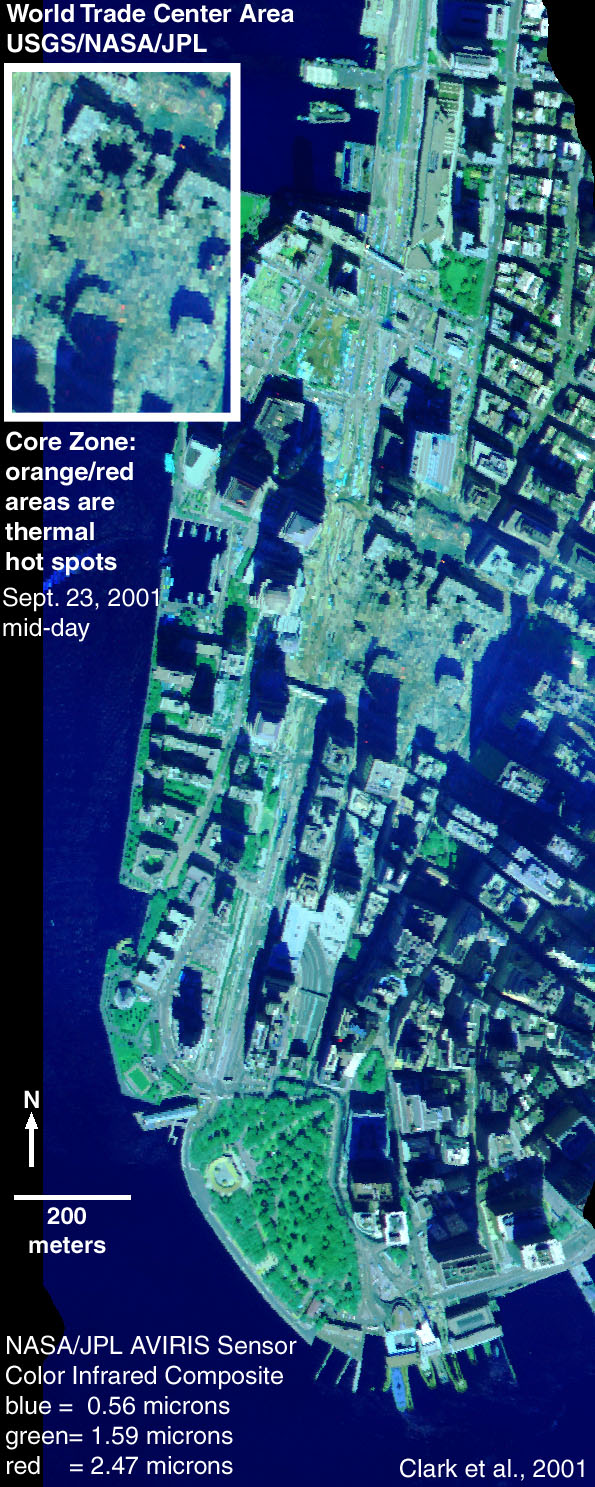

U. S. Geological Survey, Open File Report OF-01-405
Roger N. Clark1, Robert O. Green2, Gregg A. Swayze1, Todd M. Hoefen1, K. Eric Livo1, Betina Pavi2, Chuck Sarcher2, Joe Boardman4, and J. Sam Vance3
1U. S. Geological Survey,
Denver, Colorado
2Jet Propulsion Lab
Pasadena, California
3U.S. Environmental Protection Agency
Denver, Colorado
4Analytical Imaging and Geophysics, LLC Boulder, Colorado
This report presents results of Airborne Visible/Infrared Imaging Spectrometer (AVIRIS) remote sensing data and interpretations that map the distribution and intensity of thermal hot spots in the area in and around the World Trade Center on September 16 and 23, 2001. Data collected on the 16th were processed, interprested and release to emergency response teams on the 18th of September, 2001. The September 23 data were processed, interpreted and the results released on October 12, 2001. The images of the World Trade Center site show significant thermal hot spots on Sept. 16, 2001. By Sept. 23, 2001, most of the hot spots had cooled or the fires had been put out.
The AVIRIS instrument is a National Aeronautics and Space Administration (NASA) remote sensing instrument that measures upwelling spectral radiance in the visible through short-wavelength infrared. The instrument has 224 spectral channels (bands) with wavelengths from 0.37 to 2.5 microns (micrometers).
In response to requests from the EPA through the USGS, NASA flew AVIRIS on a De Havilland Twin Otter over lower Manhattan at mid-day on September 16 and 23, 2001. For these deployments, the Twin Otter was flown at altitudes of 6,500 and 12,500 feet. The spectral data for the maps shown here were measured at 6,500 feet and have a spatial resolution (pixel spacing) of approximately 6 feet (2 meters).
AVIRIS records the near-infrared signature of heat remotely. The
accompanying maps are false color images that show the core
affected area around the World Trade Center. Initial analysis of these
data revealed a number of thermal hot spots on September 16 in the region
where the buildings collapsed 5 days earlier. Analysis of the data
indicates temperatures greater than 800oF. Over 3 dozen hot
spots appear in the core zone. By September 23, only 4, or possibly 5, hot
spots are apparent, with temperatures cooler than those on September 16.

The images (larger area shown below) also show vegetated areas as green. Water appears blue, and the smoke from the fires appears as a light blue haze. White and lighter blue areas are rooftops, roads, and concrete as well as dust and debris from the collapsed buildings. Dust, probably more than a millimeter thick, appears in shades of brown.
On the September 16th, 2001 image, large areas around the World Trade Centers show brownish colors, indicating the debris. On September 20, 2001 there was a significant rain storm that washed away some of the dusty debris. Reduction of the distribution of dust/debris is apparent in the September 23 image, and can be attributed to the cleanup effort along with the rain.
There are other red/orange spots that show in the images in the area south of the World Trade Center zone. These are hot spots from chimneys or heating exhaust vents and are normal and not other uncontrolled fires.
The AVIRIS data were processed at the Jet Propulsion Laboratory (JPL) in Pasadena California where the data are calibrated to radiance and corrected for aircraft yaw, pitch, and roll. Acquisition and calibration of AVIRIS data at JPL are under the direction of Dr. Robert O. Green. The data were then transmitted to the U.S. Geological Survey (USGS), Imaging Spectroscopy Group in Denver, Colorado, under the direction of Dr. Roger N. Clark. Atmospheric and ground calibrations were applied to derive apparent surface reflectance and maps were then made of surface materials. The USGS imaging spectroscopy group includes Dr. Gregg Swayze, Eric Livo, and Todd Hoefen.
For further information, contact:
Dr. Roger N. Clark
rclark@usgs.gov


For information about AVIRIS, contact:
Robert O. Green
AVIRIS Experiment Scientist
rog@spectra.jpl.nasa.gov
Link to the AVIRIS Data Facility
| AccessibilityFOIAPrivacyPolicies and Notices | |
| |
|